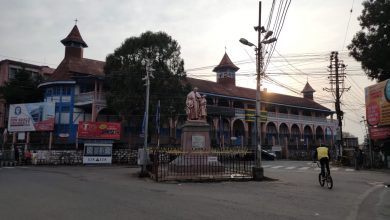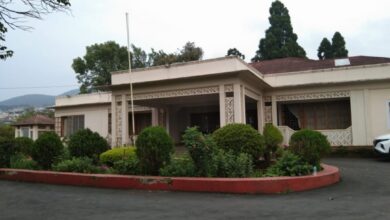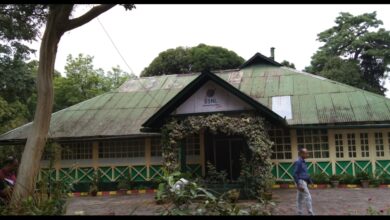HNLC: A counter view
As I was lighting up my own birthday candles, Friday the 13th also had residents of a nearby locality light up candles for the dead body of a self-styled GS of the banned terror outfit, HNLC Cheristerfield Thangkhiew (who by the way, was responsible for the untimely deaths of so many innocent people. Innocent ! And both tribals and non tribals – I might add) arrives at his residence. But who is this Cheristerfield and how did all this come about? To understand all this, we first need to know a little bit about this organisation and how it came into being – from its meteoric rise to its protracted fall.
The first time I heard of the “Saw Dak” was when this banned outfit shot dead its own army chief John Kharkrang as Thangkhiew himself confessed in an interview, “for challenging the organization and its co-founders”. Anyway, I remember reading news reports about his demise in the local papers of him being chased down a busy road in a commercial area at Laitumkhrah in broad daylight, until he ran into a post office for shelter, and was shot dead even as he was begging for someone to save him. Although the shooting was in front of dozens of witnesses, none of his killers were apprehended let alone, named. This was something that would become increasingly frequent as time went on.
The origins of the HNLC can be traced back to the late 80s – the exact date isn’t germane to the discussion, but is variously described at between 1988 and 1990 – at a time when setting up rebel guerrilla outfits was quite a fashion in this region. The original outfit was called the Hynniewtrep Achik Liberation Council (HALC) and the idea – so far as it had an idea – was to “liberate” the state of Meghalaya from Indian rule. The Hynniewtrep in the name referred to the Khasi and Jaintia tribes of the eastern half of the state while the Achik were the Garo tribe which inhabits the western half. Since the Garos and the Khasis have never hit it off, the outfit split almost immediately (1992) to form the HNLC and the Garo outfit, the Achik Liberation Matgrik Army (ALMA). The ALMA surrendered in the early nineties and was supplanted by a new group, the Achik National Volunteer Congress (ANVC) – which isn’t really relevant to this discussion.
Before I go further I have to say a few things that have to be kept in mind.
First, “insurgency” in Meghalaya has almost nothing to do with the popular conception of the term. “Insurgency” here is utterly without any trace of ideology or purpose and is for one purpose only – monetary gain. Get that right, monetary gain. And how does insurgency square with monetary gain? Well, in the first place, terrorists have guns. The ordinary Meghalayan not only does not have guns but wouldn’t know what to do with them if they had them. And since the average Indian citizen knows well enough not to trust in the state to protect him or her, the way to buy safety is to pay “protection money”.
So, the modus operandi of the HNLC is this: “demand notes” are handed out to businessmen and traders, especially of those belonging to minority ethnic communities. These poor sods are often fingered by their business competitors and if they don’t pay they have a choice – to be shot or to be forced right out of business. Most often, they pay a hefty amount of protection money. So the HNLC has a substantial sum of money in its war chest. And as more and more money starts coming in, from an ever-widening circle of extortion, the group starts getting political patronage. A large paramilitary organisation is something no politician worth his cut in every deal going can ever afford to pass up – and politicians here are some of the most venal. Especially in the villages, the terrorists get the politician’s will done while in the government, the politician becomes the group’s patron and protector. Usually everyone knows perfectly well who the patrons are, but nobody can do a thing. These people are far just too powerful back then. And at that time they had so much money that they start seducing and exploiting the unemployed youth by the image of glory and power, will flood into its ranks.
As one can see, they never really amounted to a hill of beans, but the figures don’t point to the absolute sway the HNLC had over civil society in those days. You couldn’t pick up a local paper, for instance, without finding the latest pronouncements of the HNLC plastered in banner headlines on the front page. The local press in effect became the mouthpieces and cheerleaders of the HNLC, and if any HNLC were ever killed in a firefight you could be assured of the local media screaming of how the government was murdering innocent tribal youth. The HNLC, despite its open violence, wasn’t banned till November 2000 – and after it was banned, I remember the local politicians falling over themselves blaming each other for the ban. About the only politician who condemned the HNLC and supported the ban at the time was the old and infirm former chief minister, and Hill State movement leader, B. B. Lyngdoh whose courageous acts back then gave us the independence we enjoy today.
But Independence Day this year was different. As I was proudly waving the Indian Flag on my rooftop, I could see a few noted “social workers” carrying black flags down below. I wonder how these “human rights crusaders” could mourn the death of a person whose organization was responsible for the death of so many innocent people in the state. Suddenly I was taken back down memory lane to January 5th 2001 when these so-called “Khlawait ka Ri” attacked an electronic showroom (Aristo Enterprises) for refusing to pay a sum demanded of them. It was a bitterly cold day with heavy clouds, mid-afternoon when a gang of these goons in camouflage uniforms drew up in front of the showroom in a taxi and opened fire through the glass panes. They shot five INNOCENT people – three salesmen and two customers, who apparently happened to be their (our) “para doh para snam”.
After the shooting, they got back inside the taxi and calmly drove off with absolutely no attempt by police to either block them or to take any action. All that happened was the state police chief, some G. Raju, thundering about how he would track down and annihilate the HNLC responsible for the attack within twenty four hours. 24 hours? It’s been 20 years! Oh, incidentally, the local media condemned that attack. They condemned the fact that two innocent “para doh para snam” had been killed. They ignored the deaths of the other three innocent dakhars. Three noted human rights activists too viz. Agnes Kharshiing, Angela Rangad and Hasina Kharbhih “condemned” for the deaths of the para khasi.
Now there is one significant thing you need to keep in mind – the victims of any terror group come overwhelmingly from the people the group claims to represent. Although the HNLC tried a few attacks on policemen, killing a few, more and more they began preying on their own “para doh para snam”. The reasons might be many – a young man refuses to join, so shoot him. Someone’s suspected to be an informer, or was just seen at the wrong place at the wrong time, so shoot him or torture him to death. Also, the extortion drive caused many non-Khasis to leave. So the HNLC had to turn to extorting from Khasis to keep raising money.
Again, we Khasis have never been historically violent or anti-India in our outlook. Right from the beginning, most of us hated and feared the HNLC and were disgusted by their violence, but could be terrorised into remaining silent so long as it wasn’t us who were on the receiving end. But after the 5/01 shooting and subsequent murders of our own “para doh para snam”, we began turning against the HNLC in large numbers. The police were getting more tips than ever, and if the HNLC was still being warned of raids it wasn’t the people’s fault. By 2002-03 about 85% or more of the HNLC’s victims were us Khasis, including many of their own men who wanted to surrender. The HNLC had to resort to stunts like massive firing in the air all around the city on the eve of Independence Day, 14 August 2002, to frighten people into line.
Around this time the HNLC began realising its own unpopularity. It set up a dummy organisation called the North East Red Army (NERA) under a cat’s paw named Ching Thangkhiew. This was made to do all the jobs that wouldn’t go down well with the public, like the kidnapping and murder of an old Khasi intellectual who had all along condemned the HNLC and the cult of violence. While the police always said the NERA was simply a front for the HNLC, the latter always denied it. In the end, when the heat grew too much, it killed its own puppet Ching Thangkhiew and destroyed the NERA.
Then something happened, apparently unrelated, that sealed the HNLC’s fate. The Meghalaya state government collapsed (as it does regularly) and after a lot of wheeling-dealing and political shenanigans the chief minister’s place went to a rank outsider, a man who won the election as an independent and had no ties to any political party, F. A. Khonglam. Khonglam was a doctor who had entered politics after retiring from his job in a hospital and he was made chief minister because he was the only candidate all the parties could agree on. They thought he was malleable. Overall, Khonglam’s short tenure (less than two years) was eminently forgettable. But he – because he had absolutely no political axe to grind – did something that finished off the HNLC. He simply gave the police a free hand.
Many times over the years I’ve made the single point – the police are the only people competent to destroy a terrorist movement. The police come from within the community. They know the people, they’re part of the people, and they have the intelligence sources that matter. Also, in North East India, the people – with excellent reasons – hate and fear the Army. They will never co-operate with the Army but they will co-operate with policemen who are their sons and husbands and brothers and lovers. The Meghalaya police was infiltrated with HNLC sympathisers in the lower ranks, but the killings of several cops and constant political interference had embittered even the sympathisers. What the police did was set up a “special operations” plainclothes group. Most of these were young men in civvies armed with AK series rifles. Many of them were former HNLC members. And they were utterly and absolutely ruthless with the HNLC.
Again, remember that the HNLC were no suicide jehadis. They were in it only for the money. The killings of even a few sent jitters through the rest. Suddenly, they no longer thought that if they were arrested they would be quietly set free after two or three weeks. Suddenly, if they were caught, they would be lucky to get out of it alive at all. Then we had the phenomenon of HNLC men “being arrested” in their own homes. This remarkable thing was always said to happen because the police were tipped off. Actually, it was the HNLC men themselves who were responsible for the tip-off. They would make sure they were arrested in front of their families and in front of the community leaders so the police couldn’t quietly take them somewhere, torture them for information, and then bump them off in staged gun battles. And if they were released, they would either take to normal jobs or at the most to petty crime. None of them returned to the HNLC. And so, suddenly, the HNLC was running out of new recruits and out of men able to undertake missions. The collapse was dramatic. They vanished even from their stronghold Mawlai, and retreated step by step to the borders with Bangladesh.
Today the remnants of the HNLC, a few score men, are all in Bangladesh, holed up in a few malaria-ridden camps, and mostly desperate to surrender. Many of them have died of disease or in internecine fights. Many have sneaked into India, like rape accused Dorphang did, to try and give themselves up for a shot at “the package”. Even the local papers hardly mention the HNLC anymore. The stories the surrendered gave the media may have been tutored, but sound logical and hang together. They’re harrowing enough – tales of being without food and being forced to work as labourers in betel nut plantations while the top brass lived in luxury and never turned up to see what was going on; tales of beatings, torture and deprivation. The courageous Bah Che was still hiding out in Bangladesh back then, but he had no way of enforcing any orders he might make. The HNLC is dead beyond recovery – even the businessmen (Marwari as well as Khasi traders) are no longer obeying extortion demands. Ok, let me rephrase that – the HNLC is dead to everyone except politicians.
By Khrawpyrkhat Khongjer,
Mawlai Nongkwar




